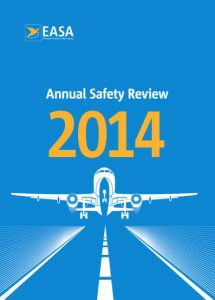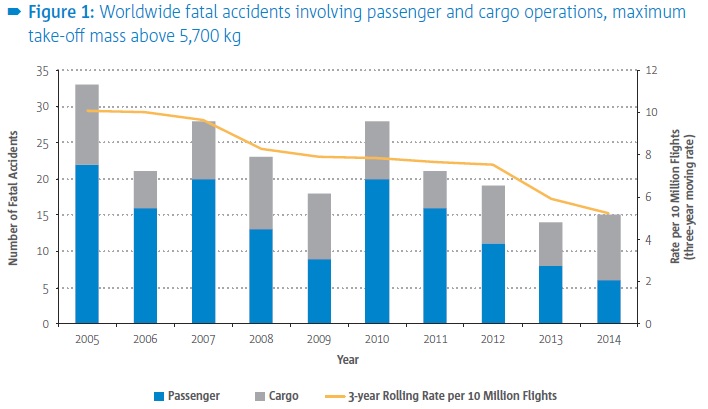EASA Annual Safety Review 2014 Published
The European Aviation Safety Agency (EASA) Annual Safety Review for 2014 is now available at: https://www.easa.europa.eu/newsroom-and-events/general-publications/annual-safety-review-2014
Worldwide in 2014, 16 fatal accidents involved Commercial Air Transport (CAT) aeroplanes (excluding MH17, that was considered to be a hostile act). This was two more than 2014, but still significantly below the average number of fatal accidents for the previous 10 years (2004-2013). The number of fatalities however rose from 185 in 2013 to 648 in 2014.
In the foreword EASA Executive Director Patrick Ky comments:
2014 has been a very challenging year for the European Aviation Safety Agency (EASA) and for aviation safety in general. The disappearance of Malaysia Airlines MH370, the dramatic loss of MH17, the crash of Air Asia [Indonesia] QZ8501 and the radar interferences over central Europe have reminded us that the safety of passengers can never be taken for granted.
Commercial Air Transport Aeroplane Performance
In the 32 EASA Member States (the 28 European Union Member States plus Iceland, Liechtenstein, Norway and Switzerland) there was one fatal CAT Aeroplane accident (MD-83 EC-LTV operated by Spanish airline Swiftair in Mali on 24 July 2014, resulting in 116 fatalities). There were 26 non-fatal accidents (up from 22 the previous year) and 66 serious incidents (down from 74).
In the EASA Member States, no more than one fatal accident CAT Aeroplane accident has occurred per annum since 2005 (with none in 2010 and 2013).
EASA has identified the 5 top risk areas for CAT Aeroplanes as:
- Loss of Control – Inflight (LOC-I in the CAST/ICAO Common Taxonomy Team [CICTT] taxonomy)
- System Component Failure (SCF = SCF-PP + SCF-NP)
- Airprox / Mid air Collision (MAC)
- Abnormal Runway Contact / Runway Excursions (ARC/RE)
- Ground Collisions / Ground Handling (GCOL/RAMP)
Interestingly Controlled Flight into Terrain CFIT does not make the list.
Commercial Air Transport Helicopter Performance
EASA say 2014 was a better year for CAT Helicopter safety:
There was 1 fatal accident in 2014 resulting in 2 fatalities. This is compared with 3 fatal accidents in 2013,resulting in 11 fatalities. There was also a 34% reduction in the number of non-fatal accidents and a 71% reduction in serious incidents compared with the 10 year average.
Based on the past fatal accident history the top 5 helicopter risk areas, in descending order, are SCF, LOC-I, CTOL, CFIT and ARC (although Low Altitude Operation, LALT and ARC are very close).
General Aviation Performance
2014 has also been a positive year for General Aviation safety, with a 20% reduction in the number of fatal accidents and an 18% reduction in the number of fatalities when compared with the 10 year average. However, there were still 173 fatalities in General Aviation, highlighting the importance of the continued safety improvement efforts.
Strategic Safety Matters
Patrick Ky also noted the agency is moving to a “more proportionate and performance-based approach to safety” with an reorganisation that creates :
A new Strategy and Safety Management Directorate…to develop a single, more transparent, evidence-based and data-driven strategy, which will drive the Agency’s work programme. The rulemaking activities were incorporated into ‘operational’ directorates, in order to increase synergies and to benefit from a better and direct operational feedback.
This year’s review includes more detailed analyses of the causes of safety occurrences. It also starts to include Sector Safety Risk Portfolios. These will directly support the European Aviation Safety Plan (EASp) which is being renamed the European Plan for Aviation Safety (EPAS) to avoid confusing with the European Aviation Safety Programme (EASP).
The initial version of the Safety Risk Portfolio for Offshore Helicopters is shown below.
This has been further developed since the deadline for the Annual Safety Review publication. The latest version was discussed by the European Helicopter Safety Team (EHEST) at its last meeting at Helitech in London earlier this month.
The EASA approach to risk is described in more detail in Chapter 2.
In relation to safety reporting EASA note that:
Mandatory Occurrence Reporting (MOR) is currently regulated, inter alia, by Directive 2003/42/EC. As of November 2015, the directive will be replaced by on the reporting, analysis and follow-up of occurrences in civil aviation, amending Regulation (EU) No 996/2010 of the European Parliament and of the Council. While some of the basic existing elements of the current MOR scheme are maintained there are some key differences.
With regard to reporting, the new Regulation introduces two types of reporting systems; mandatory and voluntary occurrence reporting. Despite the differences between the two, both will be run in much the same way, use the same process and all occurrence reports will be provided to the relevant competent authority and reported to the ECR. The types of occurrences listed in the Implementing Regulation to Regulation (EU) 376/2014 fall under the Mandatory Reporting System.
At the end of 2013 there was a total of 800,614 occurrences reports in the European Central Repository (ECR), which uses ECCAIRS software. This rose during 2014 to 953,633. There remains however issues with the quality of the data in the reports being supplied. In 2014, the average number of occurrence reports that were being integrated daily into the ECR by Member States was 398; being very close to the value recorded in 2012 but less than the value recorded in 2013 (nearly 500). No reason is apparent for the change in 2014. EASA do note that:
The value of augmenting accident and serious incident data with incident data from the ECR will bring enormous benefits to the identification of safety issues. Every occurrence report is important and the establishment of Just Culture principles in the new Regulation will help to protect anyone who reports occurrences further.
The topic was discussed further by EASA at Helitech.
Further Resources
We examined the 2013 EASA Annual Safety Report here.
UPDATE 2 July 2016: We examine the 2016 EASA Annual Safety Report.
UPDATE 19 June 2017: EASA Annual Safety Review 2017 Published
Aerossurance has previously discussed the challenges of safety management when accident rates are low: Living Near Zero – New Challenges for Air Safety
Aerossurance also first discussed Performance Based Regulation in 2014 and again this year.
Three major air safety conferences are occurring in November:
The Flight Safety Foundation’s 68th International Air Safety Summit will take place in Miami Beach 2-4 November 2015. In his keynote speech Delta Air Lines CEO Richard Anderson will discuss building and maintaining a culture with safety as the most important focus, and how to ensure that this culture resonates at all levels of the organization.
Aerossurance is pleased to sponsor the Chartered Institute of Ergonomics & Human Factors’ (CIEHF) Human Factors in Aviation Safety Conference that takes place at East Midlands Airport, 9-10 November 2015.
The Royal Aeronautical Society (RAeS) Human Factors Group is staging a conference 26-27 November 2015 at Virgin Atlantic Airways at Crawley, near London Gatwick entitled: Predicting the Fatal Flaws – Can we do things differently in aviation safety?.
Aerossurance has extensive air safety, risk, accident analysis and regulation experience. For practical aviation advice you can trust, contact us at: enquiries@aerossurance.com
Follow us on LinkedIn and on Twitter @Aerossurance for our latest updates.




Recent Comments